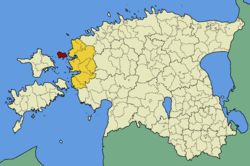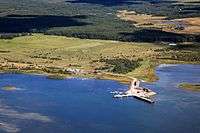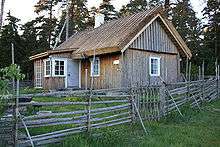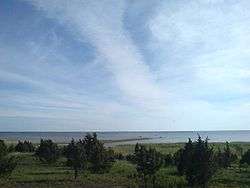Vormsi

Vormsi (Swedish: Ormsö) is the fourth-largest island of Estonia, located between Hiiumaa and the mainland with a total area of 92 square kilometers. It is part of Vormsi Parish, a rural municipality.
History
Vormsi's history as an inhabited island dates back as far as the 13th century. During most of its history, the island has been inhabited by Estonian Swedes ("rannarootslased" in Estonian or "coastal Swedes" in English), whose population reached 3,000 before World War II. During the war, nearly all of Vormsi's population, along with other Swedes living in Estonia, were evacuated, or fled, to Sweden. The island's current population is approximately 240 inhabitants.
The island's Estonian name Vormsi is derived from its German name Worms or its Swedish name Ormsö ("snake island"). Swedish influence can also be seen in other place names, as in villages like Hullo (the administrative center), Sviby (the main port), Söderby, Norrby, Diby, Rälby, Förby, Borrby, Kärrslätt, Saxby, Busby, Suuremõisa (Magnushof) and Rumpo; and lakes like Prästvik.
Literature
- Kanarbik, Madis, Ormsö. De estlandssvenska böndernas kamp mot godsägarna under 1700- och 1800-talet [Nordistica Tartuensia; 9] (Tartu, 2003)
- Beyer, Jürgen, 'Whom should one thank for a narrow escape? Lessons drawn from a perilous journey from Vormsi and Noarootsi to Finland in 1796', Pro Ethnologia 17 (2004), 175-95
Gallery
 Vormsi harbor
Vormsi harbor Saxby lighthouse
Saxby lighthouse Paddock, Rälby
Paddock, Rälby Old windmill, Rälby
Old windmill, Rälby Woodsman's cottage, Hullo
Woodsman's cottage, Hullo Beach area in Rumpo
Beach area in Rumpo
 Thatched roof house
Thatched roof house Vormsi cemetery
Vormsi cemetery
External links
| Wikivoyage has a travel guide for Vormsi. |
- Vormsi vald (Vormsi municipality)
Coordinates: 59°00′N 23°13′E / 59.000°N 23.217°E